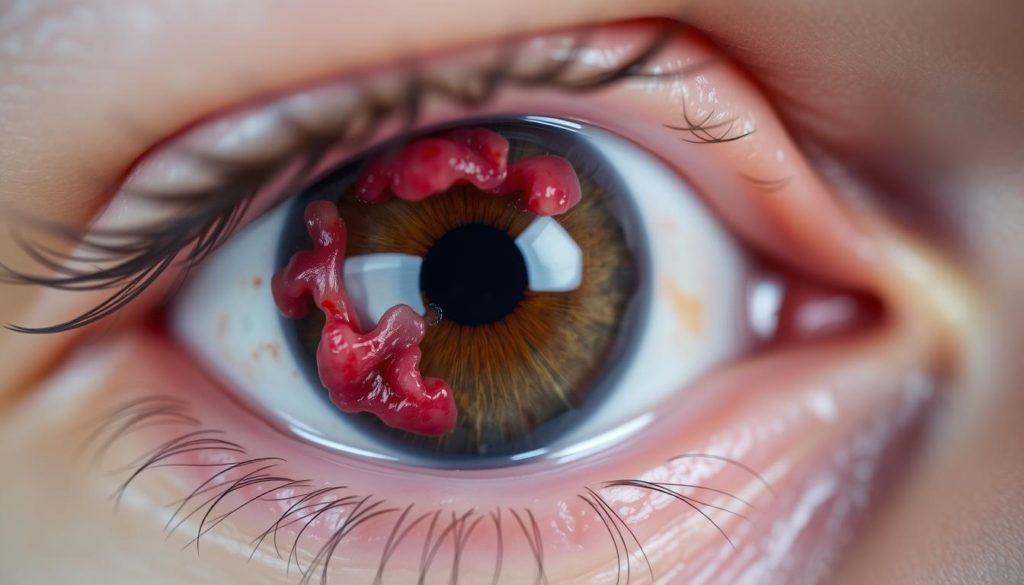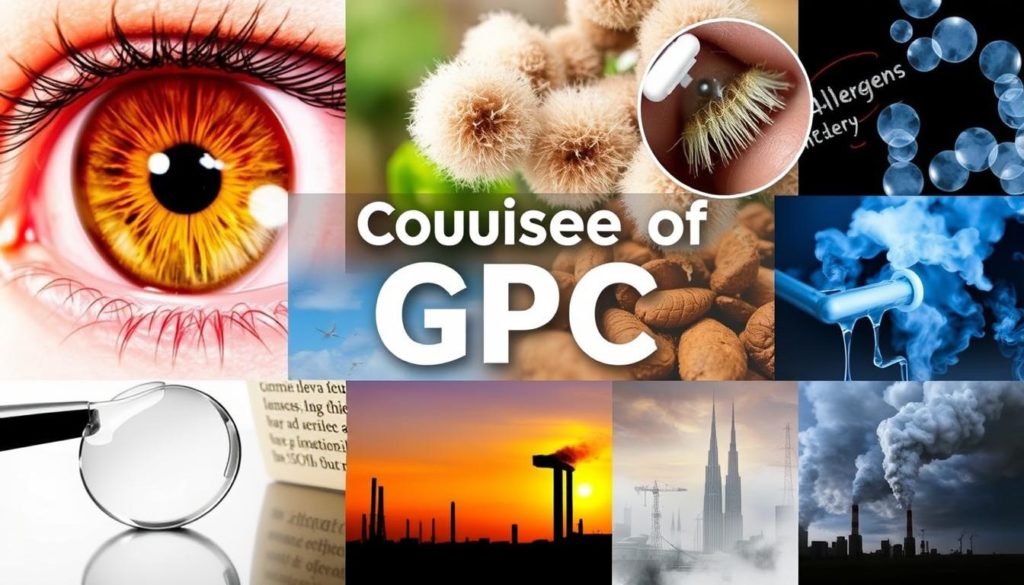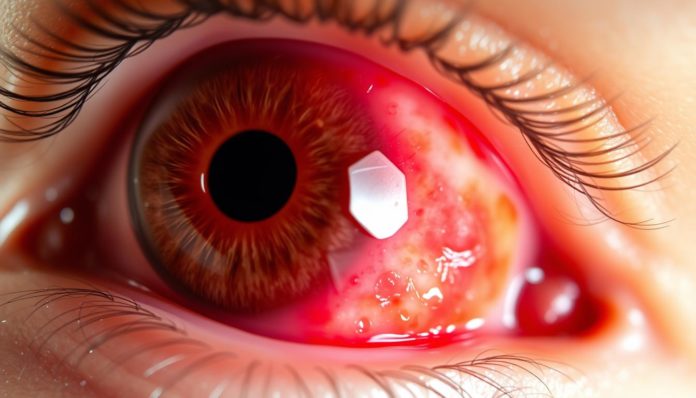Did you know about 30% of contact lens users face irritation or complications once? Giant Papillary Conjunctivitis (GPC) is one common issue. But GPC isn’t just an allergy. It’s caused by the contact lenses’ edges or foreign things like sutures.
GPC symptoms are tough, driving many to look for treatment. In the past, people thought GPC was just an allergy. Today, we know it stems from physical harm causing inflammation in the eye.
What is Giant Papillary Conjunctivitis (GPC)?
Giant Papillary Conjunctivitis (GPC) is more than what some think. It’s not an allergy but comes from lasting irritation. This overview covers what sets GPC apart, its history, and what we now know about it.

Definition and Misconceptions
Many mix up GPC with allergic reactions in the eye. Yet, GPC stems from ongoing irritation by contact lenses or other items. Understanding these key differences is crucial for the right diagnosis and treating it effectively.
Historical Classification and Nomenclature
In the past, doctors thought GPC was just another allergy. This confusion was because it looks like red, annoyed eyes from allergies. But, GPC’s caused by irritation, not an allergy. And, it looks more “bumpy” than “giant.”
Current Understanding and Correct Diagnosis
Now, we see GPC as a distinct condition from irritation. Spotting contact lens-related issues might take time, from days to years. GPC often affects both eyes. Knowing GPC well is key to spot and manage it correctly. This knowledge sets GPC apart from other eye problems.
Causes of GPC
Giant Papillary Conjunctivitis (GPC) is linked to various causes. It mainly deals with the irritation from wearing contact lenses. Other factors also play a part, differing for each person.
Chronic Mechanical Irritation
The main cause of GPC is the rubbing between the eye and the contact lens. Each blink rubs the lens against the eye, causing inflammation and papillae. This constant irritation causes the eye’s conjunctiva to respond by growing more.
Contact Lens Wear and Other Foreign Bodies
Contact lens users face a higher risk of getting GPC due to irritation by foreign objects. Soft lenses, hard lenses, and even things like sutures can cause problems. The type of lens or object greatly influences GPC’s severity and symptoms.

Additional Contributing Factors
GPC’s complexity isn’t only about irritation. It also involves atopic tendencies and eye allergy causes. A person’s eye health, allergy history, and sensitivity to substances are key in GPC’s development.
Symptoms of GPC
Knowing about *GPC symptoms* is key to recognizing and managing this eye issue quickly. It is often marked by tiny bumps on the *tarsal conjunctiva*. GPC can show various primary and secondary signs. These can look like symptoms of other eye diseases but have their own features.
Primary Symptoms
The main *GPC symptoms* consist of:
- Persistent red eyes, especially after removing contact lenses
- A feeling like something is in the eye
- More tears or mucus than usual
These signs show up due to inflammation of the *tarsal conjunctiva*. This can also lead to discomfort, making daily tasks hard.
Secondary Symptoms
Other symptoms linked to GPC include:
- Mucus that is stringy or sheet-like
- Feeling uneasy when touching the upper eyelid
- Eye redness without the itchiness seen in *ocular allergies symptoms*
How bad and how these symptoms appear can really change. This is especially true for soft versus hard contact lens users.
Distinguishing GPC from Other Eye Conditions
Distinguishing GPC from other eye issues, like viral or bacterial conjunctivitis and Vernal Keratoconjunctivitis (VKC), is critical. GPC and VKC can both cause bumps on the conjunctiva. However, itching, a common sign in VKC, is rare in GPC.
| Condition | Common Symptoms | Key Differences |
|---|---|---|
| GPC | *Red eyes*, foreign body sensation, mucus production | Papillae on *tarsal conjunctiva*, discomfort without itching |
| Bacterial Conjunctivitis | Redness, discharge, eyelid crusting | Indicators of pus and bacterial infection |
| VKC | Itching, giant papillae, mucus production | Extreme itching, often occurs seasonally |
How GPC Differs from Allergic Reactions
Giant Papillary Conjunctivitis (GPC) is not the same as regular allergic reactions. This is important for diagnosing and treating it correctly. GPC and eye allergies seem similar but they have different causes and features.
Pathophysiology of GPC
The way GPC works is by messing up the eye’s normal defense system, the conjunctiva. This leads to swelling. Unlike regular allergies, GPC doesn’t show high levels of histamines. That’s why it’s important to tell them apart during exams.
Comparison with Vernal Keratoconjunctivitis (VKC)
When looking at eye allergies, VKC is a good one to compare with. VKC and GPC both cause inflammation, but their causes are different. VKC is definitely an allergy, while GPC involves other kinds of molecules.
The Role of Collagen Growth in GPC
GPC has another unique sign, which is collagen growth. This often comes from things like wearing contact lenses too much. The growth causes big bumps on the eye lining, a key sign of GPC. This is something you don’t usually see in other eye allergies.
Identifying GPC in Contact Lens Wearers
Recognizing the early signs of giant papillary conjunctivitis (GPC) is key for those who wear contact lenses. The first warning sign is often discomfort while having the lenses in. This issue is usually because the lenses move too much and there’s a lot of mucus.
Optometrists look carefully for GPC by doing a detailed ocular examination. They focus on the upper tarsal conjunctiva. Finding papules during the exam can help confirm a GPC diagnosis.
It’s crucial to spot and treat GPC quickly to stop it from getting worse. If you wear contact lenses, make sure to have your eyes checked often. This helps catch any GPC signs early.
| Symptoms | Signs |
|---|---|
| Lens discomfort | Papules on upper tarsal conjunctiva |
| Excessive lens movement | Visible eye irritation |
| Mucus production | Redness and inflammation |
For people with contact lenses, getting eye exams often is a must. This helps find GPC early, keeping your eyes comfortable and healthy.
The Role of Contact Lens Hygiene in GPC Prevention
Keeping contact lens hygiene high is key to stop Giant Papillary Conjunctivitis (GPC). Clean and switch out lenses on time. This helps stop the build-up of harmful proteins and lessens irritation.
Proper Lens Cleaning and Replacement
Cleaning lenses right and swapping them as needed is crucial for GPC prevention. Cleaning well with the right solutions takes away debris and proteins. These can cause irritation and help bacteria grow.
Impact of Protein Deposits
Protein deposits on lenses are a big deal. They make the lens surface rough and cause more friction with the eyelid. This leads to irritation over time, which can cause GPC. So, it’s good to use enzyme cleaners to dissolve these proteins.
Specific Recommendations for Contact Lens Care
Following certain lens care tips can really lower GPC risk. Here are some important tips:
- Always wash your hands before touching lenses.
- Pick a cleaning solution that fits your lens type.
- Change your lenses as the maker or your eye doctor says.
- Keep your lens case clean and switch it out every three months.
- Don’t sleep in contact lenses unless they’re made for it.
Sticking to these guidelines helps keep your lenses clean. This means you can see better and have healthier eyes. And it lowers the chance of getting GPC and other infections a lot.
GPC Diagnosis Techniques
A reliable GPC diagnosis follows careful steps and clinical observations. Spotting and diagnosing GPC early helps a lot in treatment. It changes how we manage and help individuals with it.
Clinical Examination Procedures
A detailed clinical exam is key to an accurate GPC diagnosis. During the clinical examination GPC, eye experts check the upper tarsal conjunctiva. They look for signs of swelling or unusual growths.
The Importance of Observing Papillae
Observing papillae closely is vital in diagnosing GPC. The unique look and size of these papillae help tell GPC from other eye issues. These papillae are usually smaller than what you see with VKC. But, spotting them is crucial for diagnosing GPC.
The Use of Diagnostic Tools and Tests
Using cutting-edge tools helps spot GPC accurately. Devices like slit-lamp biomicroscopy, often with fluorescein staining, give a clear view. This allows for exact spotting of papillae. Such tools don’t just show the issue better. They also help tell GPC apart from other conditions of the conjunctiva.
| Diagnostic Method | Purpose | Advantages |
|---|---|---|
| Slit-Lamp Biomicroscopy | Examine the eye at high magnification | Detailed view of conjunctival surface |
| Fluorescein Staining | Highlight abnormalities and cell damage | Enhanced visibility of papillae and lesions |
| Tarsal Conjunctiva Inspection | Identify presence and size of papillae | Direct observation of key diagnostic feature |
Treatment Options for GPC
Treatment for Giant Papillary Conjunctivitis (GPC) includes both immediate and long-term approaches. This ensures effective control of the condition.
Immediate Relief Measures
For quick relief, patients may need to stop using contact lenses for a while. They might switch to daily disposable lenses or try a different brand to ease symptoms. Over-the-counter antihistamines can ease itching and redness. Lens cleanliness is key to preventing allergic reactions and infections.
Long-term Management Strategies
Long-term care involves lifestyle adjustments and regular eye care routines. Clearing contact lenses frequently reduces protein deposit build-up. Patients should follow strict lens hygiene and seek professional advice on lens use. Regular checks and early detection can help stop GPC from coming back and manage symptoms well.
Medications and Therapeutic Interventions
Medication and therapy are vital in treating GPC. Anti-inflammatory eye drops and ointments help with severe symptoms. Sometimes, corticosteroids are needed to lower heavy inflammation, always under professional care. Using silicone hydrogel lenses or special cleaners also aids long-term GPC management. This ensures a better experience for those wearing contacts.
| Relief Measure | Action |
|---|---|
| Temporary Cessation | Stop wearing contact lenses until symptoms subside. |
| Switch lenses | Use daily disposable or different brand lenses. |
| Antihistamines | Apply over-the-counter antihistamines for immediate relief. |
| Medical Interventions | Prescribed medications like anti-inflammatory drops. |
| Improved Hygiene | Thorough cleaning of lenses and compliance with hygiene protocols. |
For more detailed information on managing GPC and effective treatment options, click on this resource.
The Impact of GPC on Daily Life
Giant Papillary Conjunctivitis (GPC) affects everyday life for many. The irritation and inflammation make normal days hard. They turn into a struggle against discomfort and frustration.
Effect on Contact Lens Tolerance
One big GPC impact on life is less contact lens tolerance. For those wearing contact lenses, GPC makes daily life tough. Symptoms get worse, leading to contact lens intolerance. This may force a switch to glasses or look for surgical options.
Potential Complications if Left Untreated
Not treating untreated GPC complications can lead to big problems. Without the right treatment, people may suffer from ongoing eye discomfort to major visual issues. It’s important to catch and treat GPC early. This prevents bigger problems and helps keep a good quality of life.
| Aspect | Impact |
|---|---|
| GPC Impact on Life | Reduced contact lens usage, frequent discomfort, reliance on eyeglasses |
| Contact Lens Intolerance | Daily discomfort, need for alternative vision correction methods |
| Untreated GPC Complications | Chronic eye issues, potential need for surgery, decreased vision quality |
The Importance of Regular Eye Exams
Regular eye exams are key for anyone wearing contacts. They help stop GPC by finding issues early. Going for yearly check-ups lets eye doctors keep an eye on your eye health. This helps them make sure your vision and comfort are top-notch.
Another big plus of regular eye checks is they offer chances for lens check-ups. During these, eye experts look at how well your lenses fit. They make changes if needed to avoid problems like GPC. This means your eyes stay healthy and comfy.
Good eye health isn’t only about seeing better. It’s also about catching and stopping diseases such as GPC early. Regular visits let doctors find issues early. This is key for treating and managing eye health. Yearly exams are a must-do for keeping your eyes in great shape.
| Benefits of Regular Eye Exams | Reason |
|---|---|
| Early Detection of GPC | Allows for timely intervention and treatment |
| Optimization of Contact Lens Use | Ensures proper fit and reduces irritation |
| Monitoring Comprehensive Eye Health | Prevents potential eye diseases and maintains vision |
Conclusion: Addressing the Challenges of GPC
Understanding and managing Giant Papillary Conjunctivitis (GPC) involves a few key steps. It’s all about staying aware, catching it early, and taking action. To deal with GPC effectively, it helps to know it can come from allergies or other causes. A big part of handling GPC well is keeping things clean, especially for those who wear contact lenses. For more details, check out this helpful GPC management resource.
If you notice GPC signs early on, getting help right away is crucial. Knowing what causes GPC and how your body reacts can help avoid worse problems. Also, going for regular eye exams and keeping your lenses clean can prevent GPC.
Research is always finding new ways to tackle GPC. Keeping up with eye care and cleanliness is key as discoveries are made. With ongoing education and new treatments, beating GPC and keeping eyes healthy is getting easier.
FAQ
What is Giant Papillary Conjunctivitis (GPC)?
GPC is an eye condition that happens due to chronic irritation. This is often caused by the edges of contact lenses or other objects like sutures. It makes the inside of the eyelid inflamed and small bumps form.
How is GPC different from regular eye allergies?
GPC comes from physical damage, not an allergic reaction. Unlike regular eye allergies that involve histamine, GPC does not.
What are the main causes of GPC?
The main cause of GPC is irritation from contact lenses or foreign objects. Atopic conditions, which are related to allergies, might also play a role.
What are the primary symptoms of GPC?
People with GPC often have tears, feel like something is in their eye, and see redness. They might also make stringy mucus. Contact lens wearers may feel more irritation and notice their lenses move too much.
How can I differentiate GPC from other eye conditions?
GPC’s symptoms like growth of bumps on the eyelid, no itching, and its unpredictable start help tell it apart. Tools like slit-lamp biomicroscopy are used to correctly identify it.
How does proper contact lens hygiene help prevent GPC?
Keeping lenses clean and replacing them when you should prevents protein build-up and injuries. It’s very important to use the right cleaning solutions and follow lens replacement guides.
What diagnostic techniques are used to identify GPC?
Doctors look at the upper part of the eyelid to spot bumps for GPC diagnosis. They often use tools like slit-lamp biomicroscopy and fluorescein staining to see better and diagnose accurately.
What are the treatment options for GPC?
Treatment involves stopping lens use for a while, trying different lens types, or moving to daily disposables. Antihistamines are helpful if allergies are also present. In the long run, one might need to fix the cause of irritation and choose better lens materials.
How does GPC affect daily life?
GPC can make wearing contact lenses hard and cause a lot of discomforts. If not treated, it can lead to more discomfort and vision problems. This may force some to wear glasses or consider surgery.
Why are regular eye exams important for preventing GPC?
Going for eye checks regularly helps catch and treat GPC early. Yearly exams check the health of the eye and conjunctiva. This keeps your vision clear and your eyes comfortable, especially for those wearing lenses.


